- Article tells you all about Sohrai Art, why and how
made and by whom and how (raw materials, process and colours used).
Sohrai
paintings are age-old tribal traditional paintings based on nature themes like
forest, people, and animals. The paintings are done by adivasi women using
natural ingredients such as different shades of clay and charcoal. Earlier,
tribal women used ‘miswak (datuns)’ to paint the walls of their house with this traditional art.
Credits for article are with Sakshi Kumari.
This article was first published Here
Original Sohrai paintings
In
Hazaribagh district of Jharkhand an indigenous art form is practiced by the
women. Ritualistic art is done on mud walls to welcome the harvest and to
celebrate the cattle. The women clean their houses and decorate their walls
with murals of Sohrai arts. This art form has continued since 10,000–4,000 BC.
This
art form was prevalent mostly in caves but now has been primarily shifted to
houses with mud walls. But with the extinction of its natural canvas, the
biggest challenge for the art form is to retain its original spirit. It doesn’t
matter whether the canvas is mud or glass or a computer screen. In the end, art
is greater than the pen and ink it is written with.
History
According
to the Santhal tradition, Marang Buru
(god of the mountains), Jaher ayo
(goddess of the forest) and the elder sister of the Santhals, would descend on
earth from heaven to pay a visit to their brothers and to commemorate this
event.
The
harvest festival is celebrated at this time and women decorate their walls with
murals of Sohrai arts. These paintings are believed to bring good luck. It’s
from here that this art originated, adding to the culture and traditions of
India. Useful article
on this art form
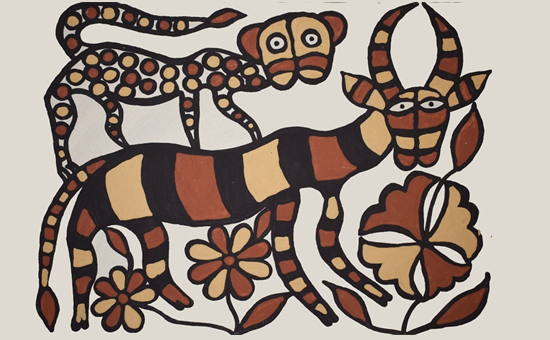 Pic courtesy The Hindu
Pic courtesy The Hindu
The name
The
name ‘Sohrai’ is said to have derived from a paleolithic age word - ‘soro’,
meaning ‘to drive with a stick’.
The festival
Sohrai
is a five-day festival of the Santhal, Munda, Prajapati, Khurmi and Oraon tribes
in the Indian states of Jharkhand, Chhattisgarh, Odisha, and West Bengal. In
some areas it is shortened to three. It is held at the start of the winter
harvest season.
It
is celebrated during Amavasya in Kartik (October-November) month as per the Hindu
calendar. In some regions, it is celebrated in mid-January. The festival is
similar to Diwali. People clean and re-paint the house. In the night, they
light earthen lamps in the cattle-sheds and offered sacrifice to the deity of
animals Pasupati. The festival is accompanied by variety of rituals,
consumption of handia (rice beer) in copious quantities, dancing,
singing and merry making.
Deciding the date
The
date of the festival is usually decided by the Manjhi, the village headman in
consultation with the elders of the village. There is no fixed date marked off,
thus celebrations are often staggered across villages, within the traditional
time frame. The purpose is to enable the villagers to celebrate Sohrai in their
own villages as well as in their relatives, especially married sisters and
daughters.
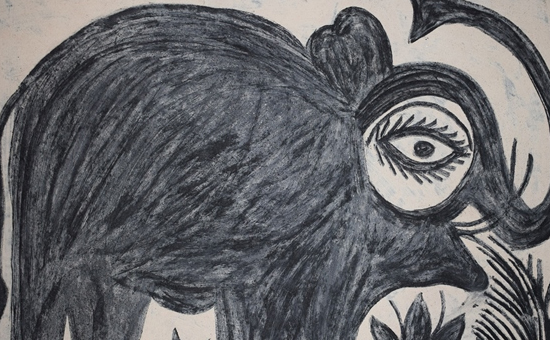 Pic courtesy Artsofearthindia.in
Pic courtesy Artsofearthindia.in
To see
more pictures
Day 1
Rituals
and sacrifice of hens are conducted by the village priest in an open space as
an invocation for their gods. It is only attended by men. The same hen is then
cooked and served as a feast with boiled rice. With this, the manjhi announces
start of the festival.
Day 2
The
second day is devoted to invoking blessings from the gods for individual homes.
The cattle are sent to the fields in the morning to graze. In their absence,
the women folks of the house decorate the huts by painting them. Meanwhile,
food is prepared which would serve as prasad after the puja.
Upon
returning, the cattle are warmly welcomed. Their horns are anointed with oil
and vermilion. Garlands made by strewing paddy strands are tied across their
foreheads. When the puja gets over, the prasad is distributed among the
villagers.
Day 3
Amid
the loud sound of drums, the cattle are taken to an open field where they are
let loose for games and recreational purposes. The women also join the menfolk
this day.
Raw materials
The
distinctive Sohrai art painted on the mud walls is a matriarchal tradition
handed down from mother to daughter.
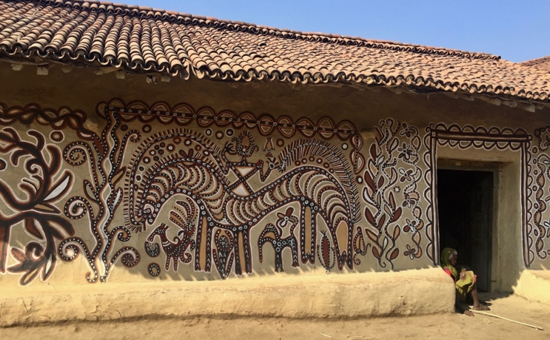 Mud wall painting.
Mud wall painting.
These
colourful paintings are done totally by using natural pigments mixed in mud-Kali
matti, Charak matti, Dudhi matti, Lal matti (Geru), and Pila matti. Artists use
datoon or cloth swabs daubed in
different earth colours to paint on the walls - bulls, horses with riders, wild
animals, trees, lotuses, peacocks, and horned deities.
Sohrai
paintings are considered to be good luck paintings.
The process
The
wall is first coated with a layer of white mud. While the layer is still wet,
they draw with their fingertips on it. The cow dung
that was earlier used to cake the walls of the house is used to add colour. The
dark outline is visible due to the previously applied contrasting white mud
coat. The canvases range up to 12 x 18 feet. The designs are usually drawn from
the artist’s memory. The personal experience of the artist, and their
interaction with nature are the biggest influence.
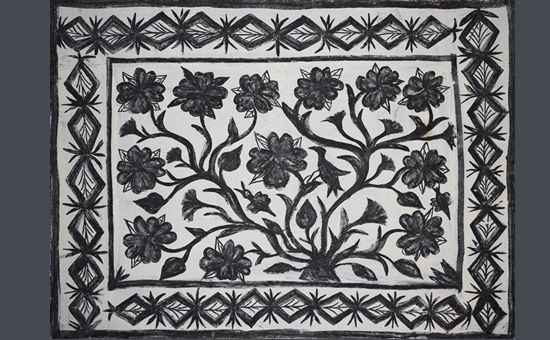 Sohrai Art.
Sohrai Art.
Also read Sohrai, the traditional paintings of the Santhalis
The significance of colours
The
Sohrai art, painted on the mud wall, is a tradition handed down from mother to
daughter.
It
is a symbolic-sacred art form of signs that carry multiple meanings. The house
it covered with black earth representing the womb; the black earth is covered
with the white earth called Dudhi
(milk) representing the god and the symbols of sperm and light.
When
the white is covered entirely over the black earth and cut with a comb, the
result is seen as a transformation of inert earth into an expression of the
mother goddess.
The
red line is drawn first as it represents the ‘blood of the ancestors’,
procreation and fertility.
The
next line is black which signifies eternal dead stone and mark of the God,
Shiva.
The
next all-encompassing outer lines stand in their traditional values of
protection, fidelity, and chastity.
The
white is painted with the last year’s rice, grounded with milk into gruel. This
represents food.
Also read Mural
Traditions of Jharkhand
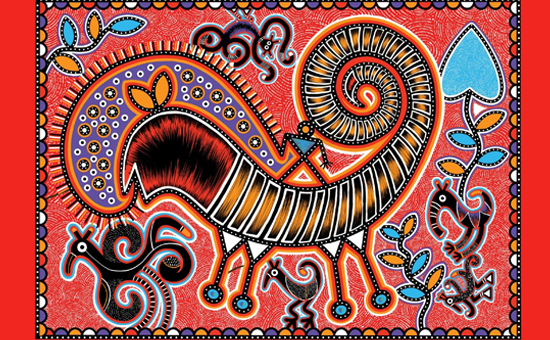 Sohrai art.
Sohrai art.
How to paint Sohrai Paintings?
Sohrai
tribal painting is sometimes painted with one colour and sometimes with
multiple colours. But the colours are all-natural dyes. Brown, yellow
ochre, red, black and other earthy colours are used to paint. Now one can see
these painted on Government buildings and railway stations as a step to promote
this form of art but the colours used here are synthetic.
The
designs in Sohrai folk art range from flowers and fruits to various other
nature-inspired designs. The animals are quite big and prominent and the leaves
and flowers fill the rest of the drawing space. The personal experience of the
artist and his interaction with nature is the biggest influence on this art.
The
patterns are simple. There is hardly any geometrical shape in them and mostly
curves and rounds which make it look natural. The thick black outlines
alternating with colours make the paintings bright and beautiful.
The
distinctive Sohrai art painted on the mud walls is a matriarchal tradition
handed down from mother to daughter. These colourful paintings are
done totally by using natural pigments mixed in mud — Kali matti, Charak matti,
Dudhi matti, Lal matti (Geru), and Pila matti. Artists use datoon (teeth
cleaning twig) or cloth swabs daubed in different earth colours to paint
on the walls — bulls, horses with riders, wild animals, trees, lotuses,
peacocks, and horned deities. Sohrai paintings are considered to be good luck
paintings.
Also readc Interesting facts of Sohrai/Kohvar art
Conclusion
Jharkhand’s
crafts including the Sohrai painting, form a very significant part of the
Jharkhand state’s cultural tradition in India. The Jharkhand crafts show a lot
of skills. But the craftsmanship quality is not balanced with the requisite
promotional activities.
As
a result, the Jharkhand crafts as a whole have not earned the national and
foreign acclamation that it deserves.
Sohrai
paintings, which are religious, secular and important to a woman’s world, are
among India’s most delicate, frail, artistic and endangered indigenous
cultures. It is the craft performed primarily by married women, after weddings
and through harvest, and the knowledge and experience are passed on to younger
students.
So,
it is necessary to save and promote the art form. The young designers should
find creative ways to incorporate the art style in their collections. This
would not only give a contemporary twist to the painting but also help in
preserving the fabulous art.
To read all articles by author
The Also Read are also references. The purpose of this compilation is to document and promote local art forms.